Samsung Epic 4G Review: The Fastest Android Phone
by Anand Lal Shimpi on September 6, 2010 5:28 PM EST- Posted in
- Smartphones
- Samsung
- Epic 4G
- Gadgets
- Mobile
The Display: Like AMOLED, but Super
Did I mention Samsung also makes displays? The Epic 4G and the rest of the Galaxy S line are among the first to use a new type of active matrix OLED called Super AMOLED. The main difference appears to be that the capacitive touch layer and AMOLED are now integrated rather than laying on top of one another. This sounds a lot like the manufacturing technique used in Apple’s Retina Display. It’s supposed to reduce unwanted glare/reflections and improve the efficiency of the display.
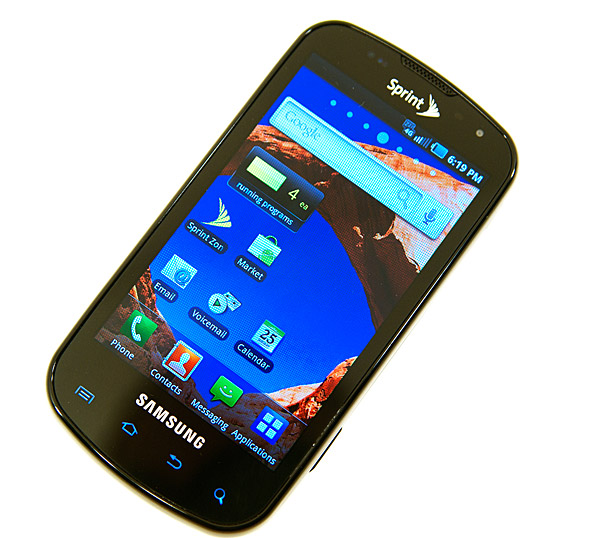
The end result is very noticeable. The Epic 4G is much easier to read outdoors compared to the original AMOLED Android phones like the Nexus One:
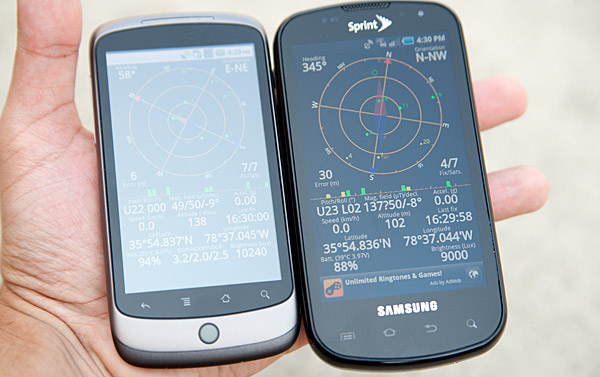
Google Nexus One AMOLED (left) vs. Samsung Epic 4G Super AMOLED (right)
The Super AMOLED display is a nice improvement over the standard AMOLED. I’d even go as far as to say that it’s comparable to most LCDs in direct sunlight, at least when you’re looking at things that aren’t white. Displaying white is a problem for AMOLED screens, it eats up a ton of power since the technology is emissive without the use of a backlight.
Direct Sunlight
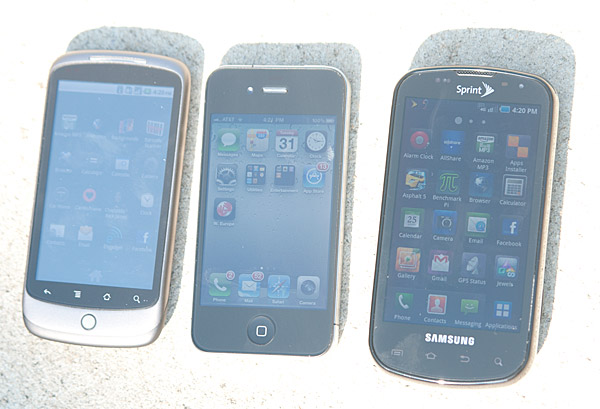
From left to right: Google Nexus One, Apple iPhone 4, Samsung Epic 4G
Shaded, Outdoors
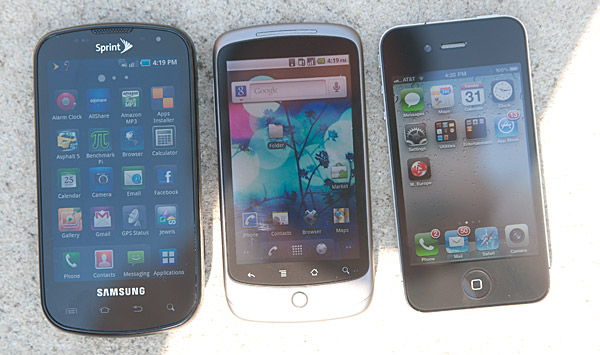
From left to right: Samsung Epic 4G, Google Nexus One, Apple iPhone 4
The biggest selling point of AMOLED is its deep blacks, which the Epic 4G’s display delivers perfectly. The display is almost too contrasty. The bright blue text on black background in the settings pages just pops.
Brightness is an issue with the display. The brightest white I measured was only 300 nits:
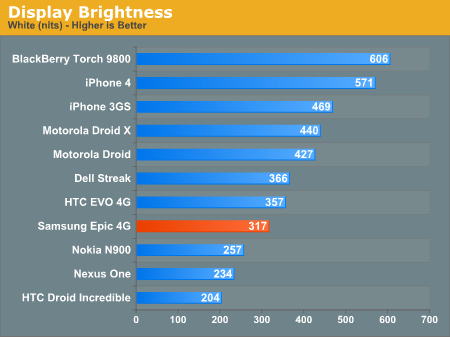
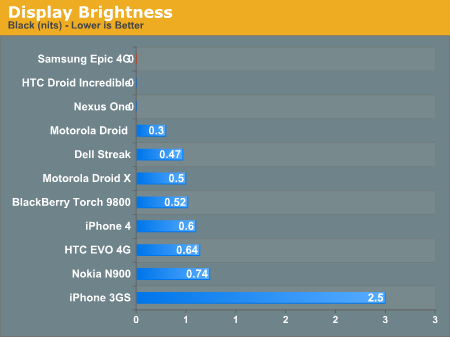
Samsung gets away with a relatively dim device by having perfect black levels, but the display’s weakness is visible when reading web pages with mostly white backgrounds.
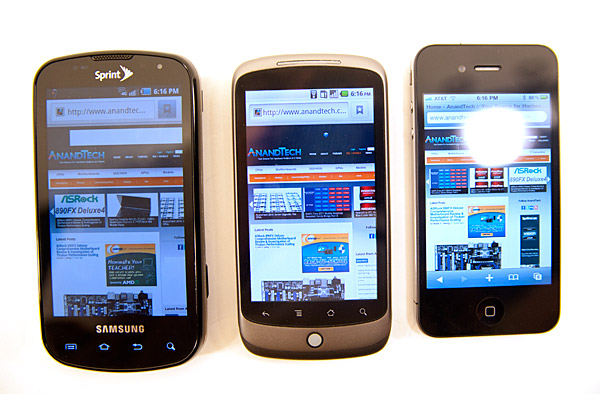
From left to right: Samsung Epic 4G, Google Nexus One, Apple iPhone 4
In the photo above, the Nexus One looks brighter, but the Epic 4G's white levels measure higher. I suspect this may be a Super AMOLED vs. AMOLED issue with our x-rite colorimeter. In practice the Nexus One has brighter pure whites while the Epic 4G has a brighter display in any other situation (e.g. home screen).
As AdamPflug correctly pointed out, the Epic 4G's web browser has a separate brightness setting which explains the difference in brightness above in the browser. In this case the brightness was set to around 20% of maximum on the Epic 4G.
Samsung includes a dynamic display feature that reduces brightness depending on the contents of the screen (there’s also the standard auto brightness based on ambient light). It’s not that noticeable when turned on in most situations but it reduces maximum brightness by about 100 nits. Again, this is mostly an issue with web pages that have a lot of white in them.
I’d say Samsung’s Super AMOLED is in the running for best display on a smartphone up there with the iPhone 4’s Retina Display. Apple has the resolution advantage, but Samsung has a huge contrast advantage. The former is nicer for reading text, while the latter is better for just about everything else.
Even if you don’t get the Epic 4G, Super AMOLED displays are where it’s at. They’re far more usable outdoors and you still get the contrast benefits of AMOLED.










93 Comments
View All Comments
SomeAudioGuy - Monday, September 20, 2010 - link
Hey Dane74,Here's the deal. I've had the phone for three weeks BEFORE it was officially released (I also write for a tech blog). You can look at pictures of SOMEONE else using metric apps, and trying to tally measurements in lab-like conditions, or you can use the phone.
You know what, lets look at Anand's pic. Next to the Nexus 1, it's off by 30m, but has found one additional satellite over the N1. It's only locked to 3 satellites, but is reading better signals from the other satellites it hasn't locked. SO this is probably not a hardware issue (if we're to base EVERYTHING on one pic published by a reviewer that doesn't seem to like this phone that much).
I GeoCache A LOT. Using the GPS in the phone to geocache in really challenging environments to get good satellite line of sight (like the canyons in LA), I'm still within 5 meters. This is comparing the on screen data to map and compass.
Samsung might have issues, but it isn't "Fooling" me. They haven't written any malicious software, they aren't trying to hurt you, they aren't trying to trick you, they aren't evil-ly twiddling their fingers laughing "Muah-ha-ha" style at their customers while petting white cats. They've admitted they have some software issues, and are working on a patch.
My locks do take longer than my EVO, but are CONSIDERABLY faster than my Fascinate (Yes. I have all of these phones.) If the EVO is more accurate, I can't tell when I'm outside or doing turn by turn navigation. Truthfully, for all of the advantages that the Epic offers over any other phone, if it's only accurate to 4 meters and the iphone is accurate to 2 meters, the iphone can STILL shove it. I'm driving/walking/riding a bike NOT engaging in surgical missile strikes...
As to whether or not turning GPS on and off creates problems, I can't say. I haven't had any of these issues. My issues usually stem from not having good line of sight (like when I'm downtown).
Jeff7181 - Tuesday, September 7, 2010 - link
Very helpful review... I almost bought one of these. I was hoping with the AMOLED the battery life would be better than the Evo 4G since it actually turns off black pixels from what I hear. Unfortunately that doesn't seem to help. Looks like I'll be keeping my Curve a while longer.michael.gulde - Wednesday, September 8, 2010 - link
Didn't see much about ports on this article does it have a hdmi port?MrMaestro - Wednesday, September 8, 2010 - link
The i9000 (international version), which I assume is the same as the Epic, has a micro-USB port. Samsung has developed a micro-USB to HDMI cable but apparently they took the Galaxy S off its compatibility list on their website, so, I think the answer is essentially no. Still, the cable isn't out yet so we'll see.DigitlDrug - Thursday, September 9, 2010 - link
Hi Anand,Thanks for another great review. I'm curious re. the supposed GPS software fix Samsung is cooking up.
Supposedly the Epic was supposed to ship with this "fix" or had at least been validated.
http://www.engadget.com/2010/08/18/samsung-says-gp...
If you are able to dig up any additional info (maybe prod the engadget boys to see if they're testing methods are as exacting as yours, and what soft. ver they have) can you please update the article or drop in a news blurb?
(I'll admit this is a big one for me, GPS is the one sticking point as I realy heavily on it.)
Thanks,
- J.
fookxixi - Friday, September 10, 2010 - link
The 30m/98.4feet GPS accuracy is a well-known bug. It won't go larger nor smaller. But from my google maps, the accuracy is definitely much better than 30m, probably ~5m. My friends' Epic don't have GPS problem either. You can not rely on the accuracy shown on some test apps.Dane74 - Monday, October 18, 2010 - link
The Epic has such widely GPS problems it is an entire section on Epic GPS issues in the Wikipedia article on it. If you are new to smart-phones, the GPS seems ok, If you know how good GPS has been on smart-phones for the past couple of years, you realize how bad Epic's is. And the picture shows the really low signal, that is the root of the problem on all the Epics.You are new to smart-phones, that is why you think the poor GPS on Epic is ok.
ELT0R0 - Saturday, September 11, 2010 - link
I've had my Epic basically since launch day, and I've noticed (and found others at xda and androidforums) that the phone has issues with both the standard 3g data and general reception.First thing is that for some reason the phone is constantly "without a signal", meaning that for some reason it is constantly searching for a cell signal (GSM?), even in areas with great reception. This can be 'fixed' by toggling airplane mode right after initial boot, and it might even alleviate some of the battery issues since the phone is no longer searching for a signal.
Second big issue is that the 3g upload data seems to be capped at 150 kbps. I have yet to see/hear/read any Epic capable of uploading faster than that on 3g. Even with full bars in the dead of night where I've been able to hit 1700 kbps download, I still get stuck at 145 kbps upload. I know for sure that my Pre before hand could easily hit 400-500 kbps under similar conditions.
Even in the review it looks as if Anand was also hitting the 3g upload wall, but it wasn't as apparent as it appeared to just be a reception issue since the area normally only gets 500 kbps U/D and the down speed at the time of testing only hit 300 kbps.
Anand, is there any way you can test these further?
Hrel - Sunday, September 12, 2010 - link
It's too bad you didn't include the DroidX in the comparison pictures. Hopefully you will when you get the Verizon version.quickbunnie - Monday, September 13, 2010 - link
"I will say that I no longer have the problem where 4G performance is worse than Sprint’s 3G in my area. I usually get around 0.5/0.5Mbps on 3G, so there’s a noticeable performance increase when WiMAX is enabled."Are you sure you are getting 0.5Mbps up on 3g?
There have been no posters with speed tests that get more than about ~150kbps up on any Epic 4G phone, even when side-by-side tests of an Evo will get 700+ kbps.
http://androidforums.com/samsung-epic-4g/166945-lo...